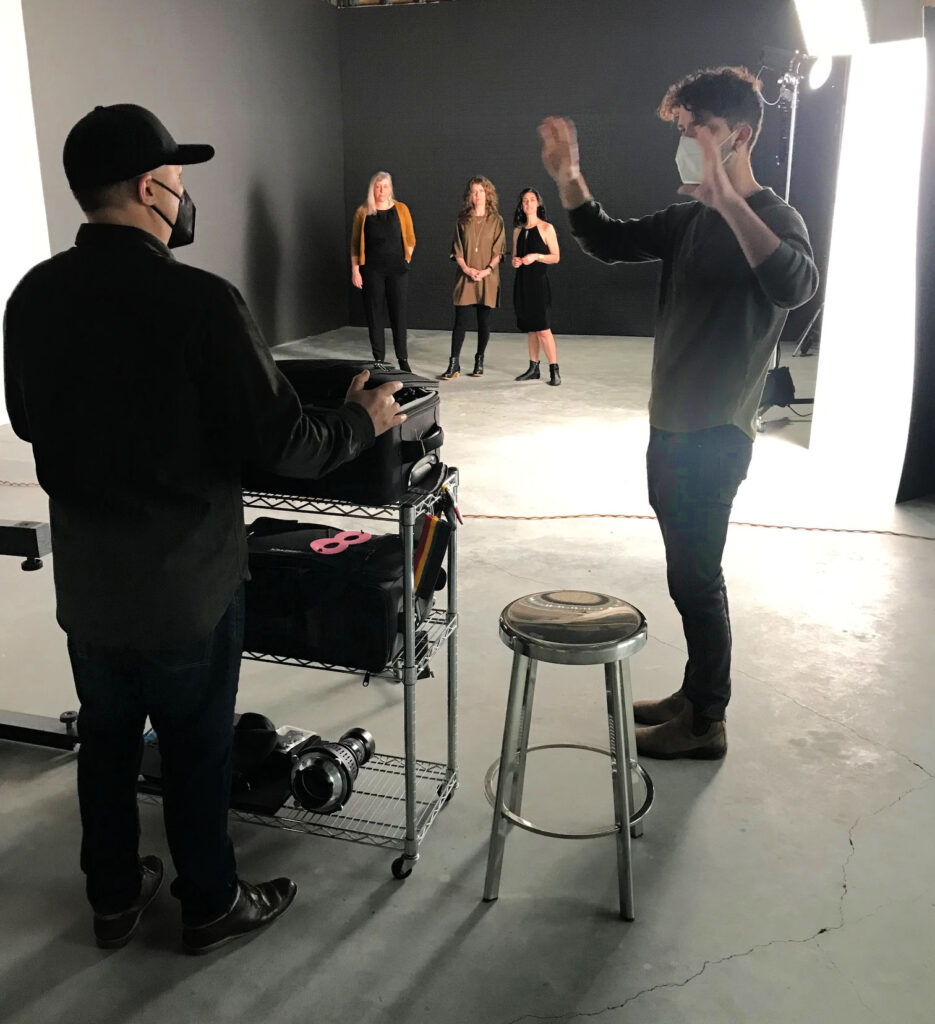Not everyone is comfortable with a camera in their face.

Speaking on camera or posing for photos can cause some of us to become self-conscious and stiffen up. We can instantly recognize when we are faking it, which leads to unflattering results. Naturally, this causes us to believe that we always look bad on camera – and so it becomes a self-fulfilling prophecy.
Meanwhile, if you’re the one holding the camera, finding ways to put people at ease is important for a successful shoot. Things can get awkward for you both if you are unable to calm someone’s nerves enough to capture their best side.
Dave Wallace, owner and video producer at Riptide Studios, has been shooting videos in Victoria for about 13 years – a career he fell into accidentally after his YouTube channel blew up in popularity.
“In 2012, businesses were trying to take advantage of viral videos and online personalities. It was the start of that transition to influencer or vlogger culture with people talking to the camera.” When Dave’s goofy sense of humour began attracting the attention of hundreds of thousands of viewers, companies started calling.
Today, Riptide Studios boasts an impressive portfolio of videos showcasing clients from the vibin’ Downtown Victoria Business Association to Laketown Shakedown music festival. We’ve worked with Dave and his team to produce the Douglas magazine 10 to Watch award show in 2022.
Confident and calm on both sides of the lens, Spark asked Dave to impart some of his wisdom about how to ease the ache of awkwardness — whether you are behind the camera or in front of it – so you get the best results.
Want to feel more relaxed on camera?
Practice makes perfect.
Put yourself in front of the camera until you get used to it.
You don’t learn a new skill without some practice. So, if you are hoping to get more comfortable in front of the camera when it matters, then you need to put yourself in front of one when it doesn’t.
“The unsexy answer is always do a hundred shoots, suck at it, and get better,” says Dave. “It’s just trial and error. Doing it over and over again, never putting it out there, and then doing it again tomorrow.”
Wash, rinse, repeat – eventually you will shine.
Lose the script.
What you say matters less than how you say it.
To appear more natural on camera, Dave advises that you bullet point what you want to say as opposed to following a script.
“It doesn’t matter if you’ve said this prefix perfectly or put everything in the exact right order. It matters a lot more that you’re talking from the heart. Prepare a bit beforehand but leave room for spontaneity and emotion.”
What about teleprompters? Dave advises against them.
“I’m not saying that teleprompters are bad. But people who use teleprompters that don’t work for news stations often feel stiff, look stiff, and their eyes are not a very emotive or passionate when they’re trying to get every word correct. Talking off-the-cuff will allow your points to flow naturally.”
Shake it up.
Do whatever you need to do to keep your energy flowing.
Sometimes we get in our heads and overthink things. Getting stuck in perfecting a moment can slow the overall momentum with multiple takes sucking the energy from the shoot.
So, what do you do when something is not working?
Dave says to move on. “Keep it fresh. It’s almost guaranteed to be better when you circle back around. If you get to the point where you’re frustrated, it’s gonna show on camera. So just take a break, take a walk, take a breather. Maybe don’t do it that day – come back another day if you have the luxury. You want to be feeling good, so you come across good.”
Go easy on yourself.
Not everything needs to be perfect.
It’s human to stumble, so don’t get hung up on the little things.
“The one thing I say the most often is, we’re gonna film you for 30 to 60 minutes, then we’re gonna use 30 seconds of it. So don’t let your nerves or one bad answer kill you.”
A lot can be cleaned up in the edit, so your most important points come across naturally and professionally. The same applies to a photoshoot – hundreds of photos will be taken, only a select few ever see the light of day. So, relax!
Pay attention to timing.
Catch yourself when you’re at your best.
Much easier said than done, but Dave advises to try to catch yourself at your best time of day and be sure to allocate enough time to get yourself comfortable.
“Everyone knows the feeling of having to come into work and you’ve got this looming thing at 11:00 PM and everything you do between 9 and 11 is not your best work. Do it when you’ve got good energy and don’t have other things in the back of your head.”
If you have the flexibility, try to schedule your shoot when you know you’ll be able to focus and be present in the moment.
Need to help others relax on camera?
Do a Pre-Interview
Build trust in your relationship and know what to expect.
Coming into a photoshoot cold can be intimidating. Pre-interviews are a great way to break the ice and assess the comfort level of the person you will be filming.
“It helps us to establish if we think someone’s going to be a little bit nervous or maybe they’re going to be a bigger part of the overall video. If someone does come through with a lot of nerves, it just lets us know that on the day of, we probably need to spend a little extra time getting them comfortable before we put a camera in their face.”
Dave acknowledges that sometimes budgets and timelines don’t allow for a pre-interview.
“At the very least, you want to have a conversation while you’re setting up the cameras. Just try to get them comfortable so that when the lights turn on, they feel like they are already your friend and you’re on the same team.”
“At the end of the day, the best result always comes when you’re comfortable both with the people around you and you understand what the goals are for what you’re creating.”
Create a comfortable atmosphere.
Be the calm you wish to see in the room.
Film and photo shoots can be stressful at the best of times. But bringing a good energy on set can go a long way to helping others feel comfortable.
It also helps to be an empathetic person and use your intuition to read the room. You want to make sure that everyone is okay on a human level as you never know what’s going on behind the scenes.
Dave explains the importance of projecting a confident vibe. “It’s kind of a rule, no running on set, because everyone around you gets stressed. You want to come into a shoot and have a calm presence and hopefully pass it on.”
The same advice goes for those in front of the camera. “If someone else is with you, make sure it’s someone that calms you down and not ramps you up. Human micro expressions all come across on camera. How you feel in that moment – if it’s not on, it’s never gonna be on.”
Offer clear feedback.
Take the time to provide proper context and guidance.
When Dave first started his career behind the camera working for larger companies, he learned from their mistakes as he watched some of them make people feel quite uncomfortable during the shoot.
“They would ask a question, someone would deliver an answer, and then very quickly they would say, “Okay, we’re gonna try that again.” Empathetically, I’m thinking that this person doesn’t know if they did something wrong or if they should be doing something differently.”
“I always make sure that people are comfortable if we need to do something again and explain why something didn’t work out. For example, maybe they didn’t give context to their answer so it wouldn’t make sense in an edit.”
“More often than not, it’s about coming back to something later and asking a few questions to warm ’em up. If something’s just not working, don’t drive it into the ground. Because even if you get that perfect, everything after that is going to suffer.”
Celebrate the good answers.
Uplifting direction yields the best results.
Praise not only feels good, but it offers positive reinforcement about how we are doing so we can stay on track.
“Celebrate those really good answers, so that the person can then go, “Oh, they really seem to like that. I’m gonna lean more into that.”
If you are filming yourself and are already camera-shy, then it’s extra hard to be objective about what works and what isn’t working. Dave suggests sending the video to someone who knows you or have them in the room so they can act as a cheerleader when you do well.
Getting comfortable in your own skin doesn’t need to be a lifelong journey, but something that comes with patience, practice, and the liberating knowledge that not every take is a keeper.
Likewise, bringing the best out in others comes more from a place of empathy and understanding than a million do-overs that simply increase the tension in the room.
Often when nerves are high, what everyone needs on both sides of the camera is a good deep breath to relax, a beat to refresh, and an attempt to come at things from a fresh direction.
If you enjoyed reading this blog …
Have a hard time with self-promotion? We share why and when to put yourself out there.
And here’s why hiring a photographer might be the best thing you do for you and your business.

